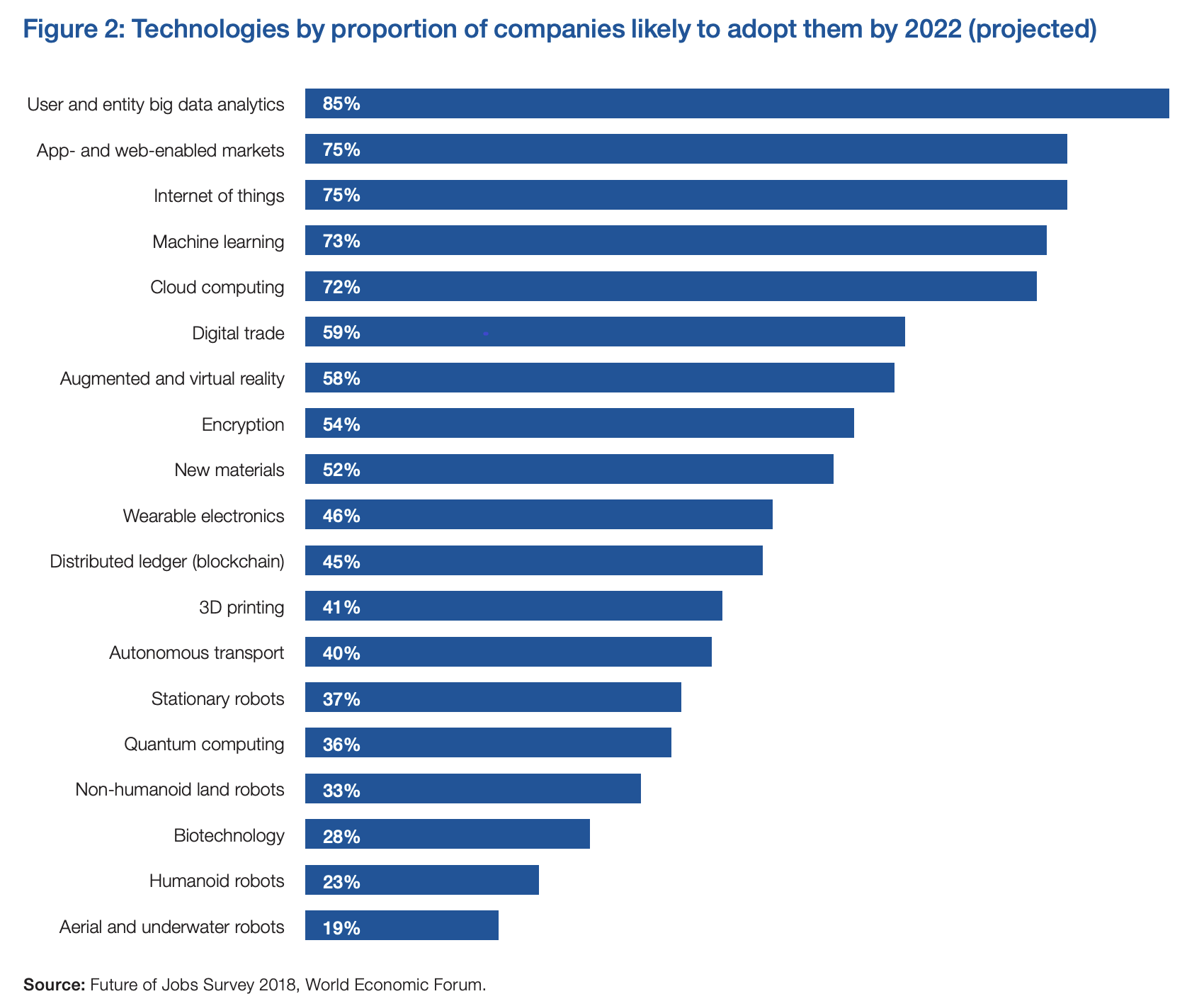Job openings left unfilled largely because candidates lack the needed technological skills are having a growing impact in some advanced economies. In the US, the available workforce is not keeping pace with a 4.7% job openings growth rate. This translates into 2 million vacant positions in manufacturing. In Germany, the number of jobs that remain unfilled for long periods of time hovers around the 1.6 million handle.
According to some estimates, in the period up to 2022, a shift in the division of labor between humans, machines and algorithms could displace 75 million jobs, while 133 million new roles may emerge. These estimates should be treated with caution, the World Economic Forum’s (WEF) Future of Jobs Report 2018 states, not least because they represent a subset of employment globally, but are useful to “highlight the types of adaptation strategies that must be put in place to facilitate the transition of the workforce to the new world of work.”
There is consensus that in the industrial sector the management and engineering departments are mostly fully involved in their digital transformation journeys; not so the factory floor, where workers often remain disconnected from the rich information ecosystem on which other functions in the enterprise have come to rely. One reason is that in manufacturing operations, internal communications and information still rely to a good degree on legacy tools and methods like the telephone and traditional hard copy or video work instructions.
The issues.
- Addressing demographic dynamics is crucial for the transfer of knowledge in the industrial sector.
- Millennials entering the workforce tend to lack the experience and training and can be more difficult to retain than earlier generations (at least in the US).
- Technically skilled incumbents are aging out of the workforce, taking invaluable experience and expertise with them.
- The skills gap, the gap between trained employees and those not trained for the new digital tools, if neglected, can only deepen because the ever increasing complexity in processes, plants, logistics and the geography of industrial operations.
- Tribal knowledge, the unwritten information known to only small groups of workers within a company, is lost.
- The analytics needed to enhance and make more efficient the management and the industrial processes are data-driven, and rely on the availability of large amounts of data. Much of the information relayed with traditional communication methods is not collected.
Augmented Reality (AR) has been around for a few years now, but is emerging today as a technology of choice in factory floors and industrial operations, also because its adoption is scalable, even if it starts small, like in the case of SMEs.
ESAB, a welding company with 10,000 employees, has, at any given time, between 200 and 500 welders on the field, that is, across the world and in any kind of plant or operations. “In the past, we needed to shoot huge amount of photos and videos, then describe the problem and talk with the experts in the headquarters,” an ESAB maintenance and emergency welder explained, as he held a tablet standing next to portable welding equipment at MWC19. “With this AR application, the engineers and experts in our operations centers can analyze in real time the area in the plant where the problem is, and tell us how to solve it”. The application ESAB uses is PTC’s Vuforia.
The ability to acquire and save data makes a fundamental difference against the previous remote communication tools, both because the data can be processed and distributed immediately to other field technicians, and because it feeds the company’s data-analytics programs, the ESAB technician explained. In their case, being that they often operate in remote areas and harsh environments with unstable connectivity, being able to save the data on the spot is crucial.
Augmented Reality allows to visually superimpose digital information on an environment or surrounding objects. AR can use devices with video-see-through technology, like a tablet or a smartphone, or optical-see-through devices, such as special glasses or Microsoft’s HoloLens.
The motion and position sensors in the AR devices establish their orientation in space. Drawing on this data, the software determines what information to provide at any given positioning point.
Unlike Virtual Reality (VR), AR does not replace the image the user has in front, but overlays information that can be measurements, graphics or drawings and details of its components, like in the case of an engine. With the Vuforia Chalk version, technicians can also draw or write on the touchscreen. Furthermore, the data collected with AR applications can be send to a digital twin of the operation being performed.
Howden is a Colfax Group global engineering company that supplies industrial products such as mine ventilation, wastewater treatment or plant heating and cooling. It adopted AR applications not only to show their customers the operating conditions and performance of their equipment in context, but also to provide predictive maintenance alerts, rapid parts identification and easy to follow repair sequences to resolving problems and preventing failures and downtime.
Leveraging on their existing 3D models, Howden uses a scalable Mixed Reality (MR) solution that integrates historical data with real time data collected though the elements of the Industrial Internet of Things (IoT) solution ThingWorx pulled on the Microsoft Azure cloud.
“Our equipment typically operates as process critical,” Maria Wilson, the Global Leader Data Driven Advantage for Howden said, “The mixed reality experience provides a way of looking at Howden equipment that customers have never had before.” Moreover, “plant operators, who are not experts on compressors, now have 160 years of compressor knowledge at their fingertips through the easily-consumable mixed reality” on a HoloLens.

“A situation that previously would take a minimum of one to two hours to resolve and perhaps require the travel time and expense to send an expert technician can now be easily handled by the customer.”According to Aberdeen research, the three main reasons driving companies to invest in new technologies are: the need to maximize efficiency, competition and the need to manage an increasingly intense turnover of labor in all industries.
Over the next 10 years, 1.37 million workers will leave the workforce, but they could be retrained for new roles at a total cost of about $34 billion, that is, on average $24,800 per displaced worker—a cost that should be borne ideally by public-private collaborations, the WEF suggests.
For upskilling (learning new competencies to stay in current role) or reskilling (learning new sets of competencies to transition to new roles), 58% of the companies interviewed by WEF plan to adopt AR over the next four years, as a tool to “help more workers to switch to highly qualified jobs”.
Research by the Goethe Institut in Frankfurt, Germany, confirms the trend that involves small and medium-sized companies and big corporations alike. The latter include GSI, the agricultural corporation, and BAE Systems, the aerospace multinational, according to which “AR is the next step in the evolution of high-tech manufacturing“.



